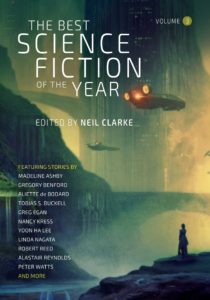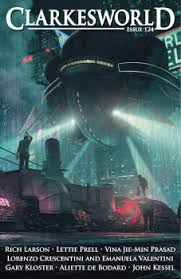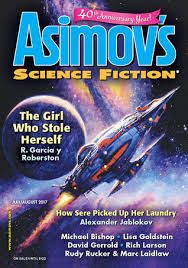 Neil Clarke and his annual anthology, The Best Science Fiction of the Year, seem well-positioned to take on the mantle of most important sci-fi anthology after the tragic loss of Gardner Dozois earlier this year. Clarke’s skill at selecting a variety of compelling science fiction tales shines in this excellent collection. There’s something for everyone here and very few weak entries — a highly recommended series, as you’ll see in our review of The Best Science Fiction of the Year: Volume Three.
Neil Clarke and his annual anthology, The Best Science Fiction of the Year, seem well-positioned to take on the mantle of most important sci-fi anthology after the tragic loss of Gardner Dozois earlier this year. Clarke’s skill at selecting a variety of compelling science fiction tales shines in this excellent collection. There’s something for everyone here and very few weak entries — a highly recommended series, as you’ll see in our review of The Best Science Fiction of the Year: Volume Three.
Published April 3, 2018 by Night Shade Books, The Best Science Fiction of the Year: Volume Three features 26 stories selected by Neil Clarke from thirteen different venues, including mostly online and print magazines and other anthologies first published in the 2017 calendar year. This inspired collection includes everything from military science fiction to time travel to cyberpunk.
We’ve highlighted a few of the best stories below.
“A Series of Steaks” by Singaporean writer Vina Jie-Min Prasad is set in a cyberpunk, near-future Hong Kong. Helen, an expert in forgeries of meat, is blackmailed into providing a large amount of faux steaks for a fancy Hong Kong wedding. In this funny and entertaining story, Helen, with the help of a great sidekick, Lily, outwit the man who is blackmailing her and manages to escape the shady criminal world of forgeries.
 Alastair Reynolds is back in strong form with “Holdfast”, featuring his signature brand of hard science fiction. Battle-Mother is effectively mano-a-spider leg pitted against an eight-limbed alien adversary called a maggot. Set in a space-faring future in which humanity is engaged in a seemingly never-ending galactic war against the maggots, and neither side seems to know too much about the other’s true nature, “Holdfast” is all action from the first sentence.
Alastair Reynolds is back in strong form with “Holdfast”, featuring his signature brand of hard science fiction. Battle-Mother is effectively mano-a-spider leg pitted against an eight-limbed alien adversary called a maggot. Set in a space-faring future in which humanity is engaged in a seemingly never-ending galactic war against the maggots, and neither side seems to know too much about the other’s true nature, “Holdfast” is all action from the first sentence.
Battle-Mother has lost her squadron, ship and offspring in a desperate battle with her maggot adversary, who is similarly depleted of weapons or means of escaping the super-jovian planet surface where they both find themselves separated by strange rocky terrain. Under the pressure of a thousand G’s, the two battle-hardened warriors engage in a brief cat-and-mouse sequence before discovering that the planet surface is some type of intelligent being.
One of the highlights of this story is the way Reynolds weaves planetary science concepts, such as how floating mountains might appear in the atmosphere of a gas giant and what a battle would look like in an extreme G environment, as well as sharing the exposition and backstory without giving up pacing. In the end, both fighters discover some type of reconciliation a la Enemy Mine.
In Nancy Kress’ excellent “Every Hour of Light and Dark”, three different timelines are woven together in a layered story about the relevance of truth and the centuries-long incompatibility of art and science. One of the highlights of “Light and Dark” is the setting of the primary timeline. The story takes place on the moon in about 200 years. The colony of survivors who live in lunar domes are the last survivors of the human race due to a manmade bioweapon called the Madness, which wiped out everyone on earth in the mid-21st century and rendered any physical contact with earth impossible. The moon dwellers have invented a kind of time and teleportation machine called the Program, capable of finding and beaming back to them rare works of art from all eras of human history. The moon dwellers try not to disturb the timestream by replacing the original art with forgeries.
 In “Martian Obelisk”, Linda Nagata writes a beautiful, bleak story about Susannah Li-Langford’s attempt to create something lasting as humanity’s chances for survival dwindle. What distinguishes “Obelisk” from other end-of-the-world stories are the lack of one catastrophic event leading to humanity’s decline and the necessity of hope to survival. Nagata realistically portrays a near-future in which a myriad of problems (disease, overpopulation) stack up against humanity. Civilization has passed a tipping point, with our best days behind us. The eponymous tower Susannah builds using remotely controlled machines is an attempt to find some meaning in her existence. The final moments of the story bring some glimmer of hope.
In “Martian Obelisk”, Linda Nagata writes a beautiful, bleak story about Susannah Li-Langford’s attempt to create something lasting as humanity’s chances for survival dwindle. What distinguishes “Obelisk” from other end-of-the-world stories are the lack of one catastrophic event leading to humanity’s decline and the necessity of hope to survival. Nagata realistically portrays a near-future in which a myriad of problems (disease, overpopulation) stack up against humanity. Civilization has passed a tipping point, with our best days behind us. The eponymous tower Susannah builds using remotely controlled machines is an attempt to find some meaning in her existence. The final moments of the story bring some glimmer of hope.
Greg Egan does a superb job of playing out the implications of AI in the near future in the realistically portrayed world of “Uncanny Valley”. The story focuses on the legal status of an AI in a level of detail rarely tackled in genre fiction. The story is also a mystery as Adam, the AI who is a duplicate of most (but not all) of his patron’s memories and being, tries to find out what biographical information about the old man’s life is being kept from him.
 Although some of the twists are slightly foreshadowed, the story focuses more on Adam the android’s plight. And he’s so well drawn as a character, it’s hard not to root for him.
Although some of the twists are slightly foreshadowed, the story focuses more on Adam the android’s plight. And he’s so well drawn as a character, it’s hard not to root for him.
Rich Larson’s “An Evening with Severyn Grimes” is probably the strongest story in the anthology. It’s a bit of an update of Gibsonesque cyberpunk noir, with healthy doses of action from start to finish. Although the story serves as hard sci-fi escapism, the writing is excellent and brimming with clever near-future concepts like the “clamp” (a kind of futuristic neural handcuff), the puppeteers, and a bodyguard named Finch augmented with Neanderthal DNA to make him extra tough.